
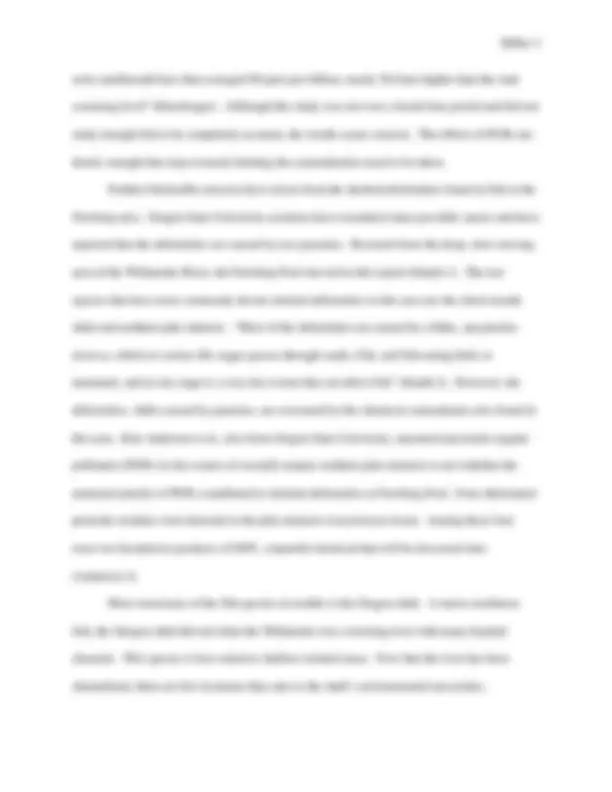
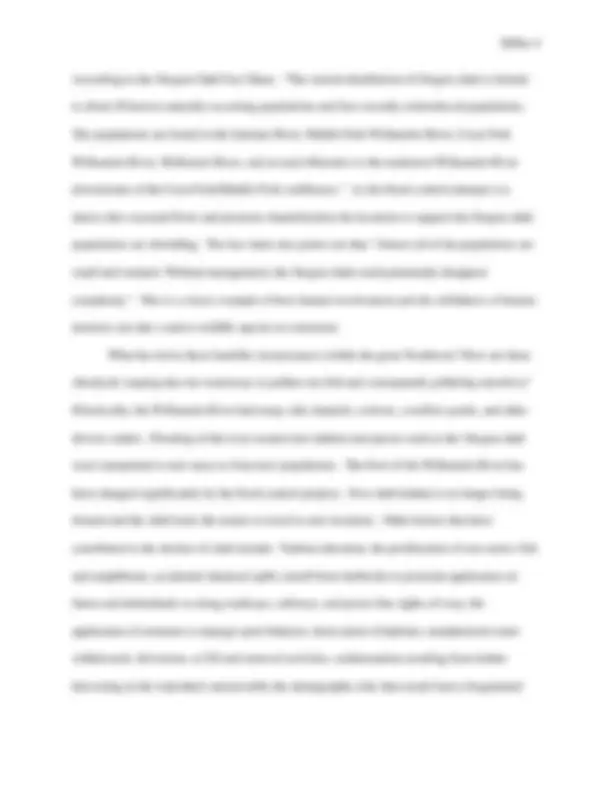
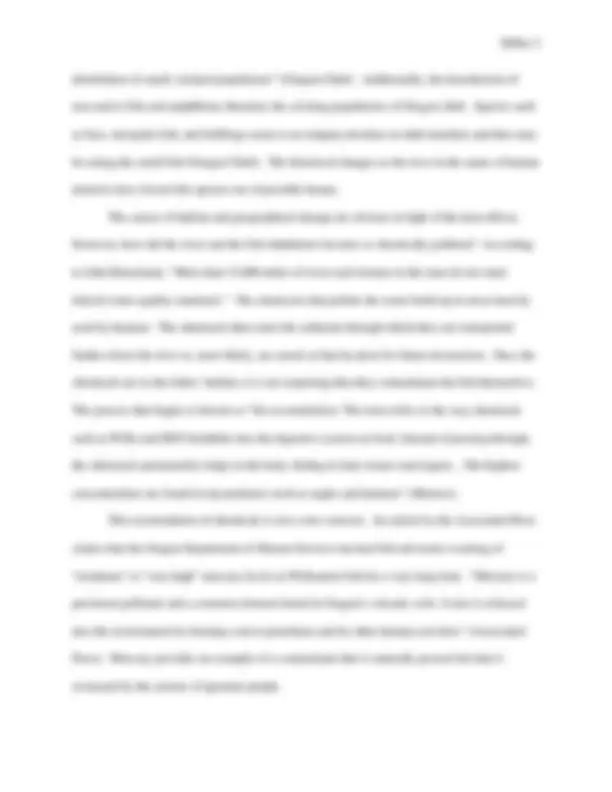
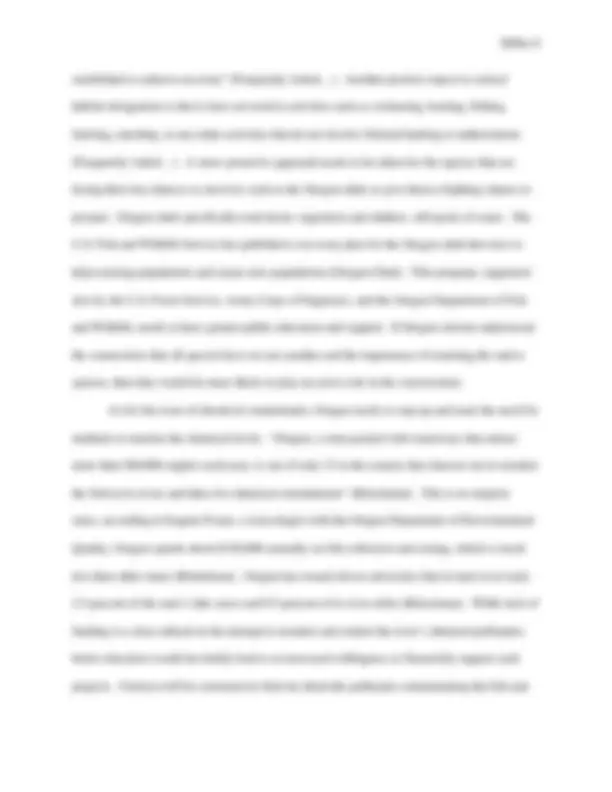

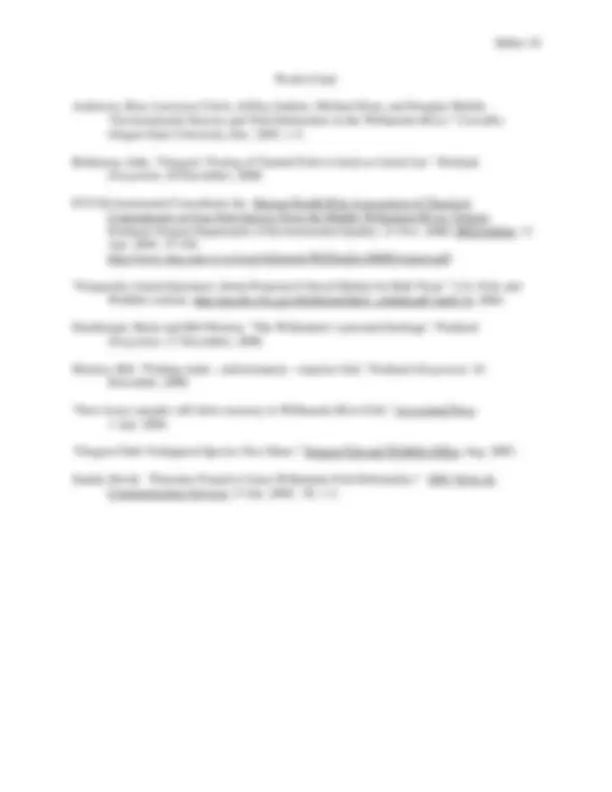


Study with the several resources on Docsity

Earn points by helping other students or get them with a premium plan


Prepare for your exams
Study with the several resources on Docsity

Earn points to download
Earn points by helping other students or get them with a premium plan
Community
Ask the community for help and clear up your study doubts
Discover the best universities in your country according to Docsity users
Free resources
Download our free guides on studying techniques, anxiety management strategies, and thesis advice from Docsity tutors
The issue of fish health in the willamette river, discussing the impact of chemical contaminants such as mercury and pcbs on fish populations. The document also covers parasites and other environmental factors contributing to fish deformities and declining numbers of fish species. The oregon chub, a native northwest fish, is of particular concern due to habitat loss and the introduction of non-native species.
Typology: Exams
1 / 10

This page cannot be seen from the preview
Don't miss anything!







Necessity to Protect the Willamette River Fish Jessica Miller HC 441: Willamette River Health Clark Honors College, University of OregonJune 3, 2004 Throughout history the status of the Willamette River has varied greatly. At times it has been a perfect representative of the stereotypical beautiful Northwest outdoors. However, the river has also been labeled the most polluted waterway west of the Mississippi. There have been numerous attempts, by the government, nonprofit groups, and individuals to clean up the river and restore it to its stunning and healthy state. As pollution and other water abuses continue, many concerns, specifically about the Willamette Valley ecosystem, take rise. Examined here is the issue of fish health within the Willamette River. Chemical contaminants, parasites, and other environmental factors contribute to the declining numbers of fish species in an area where they used to prosper. Specific examples of current situations, the history of negative inputs, and effects on the surrounding ecosystem will lead to concluding recommendations. Chemical contaminants have become a worrisome issue in relation to fish health. Among such chemicals, mercury has been found at higher than desirable levels in numerous locations and within many fish populations. “Bass, pike minnow and suckers captured in the Willamette River last summer contained elevated concentrations of mercury, some well above the threshold set for the issuance of human health advisories” (Associated Press). While many people give little thought to the health of the environment, the public will take notice if they will be directly affected. Many warnings about fish consumption are scaring people to take notice. “DEQ tests of 10 largemouth bass caught last summer at the Cottage Grove reservoir indicated an average mercury concentration of 1.63 parts per million - far above the 0.35 parts per million threshold
for state fish consumption advisories” (Associated Press). While contamination due to ingestion is unlikely if fish is prepared correctly, the warnings certainly cause concern. Consequently, many human health studies have been conducted in regards to the fish of the Willamette. A report prepared by EVS Environmental Consultants Inc. compares the present levels of mercury and toxic chemicals to those from the late 1980’s. “Based on this limited data set, concentrations of mercury, Aroclor 1254, and Aroclor 1260 are higher in the current study than concentrations in bass collected in 1988 in the same section of the Willamette River” (93). It is obviously worrisome that while regulations to control pollution have been on a rise, the measured concentrations of contaminants are increasing. Mercury is only one of the chemicals of concern within the Willamette fish and other wildlife. Polychlorinated biphenyls (PCBs) are polluting the soil and water, and thus the fish, of the Willamette. According to Brent Hunsberger and Bill Monroe in regards to a study on fish and PCB contamination, “The dirtiest fish came from the Portland harbor, now the focus of a federal Superfund cleanup.” Carp, black crappie and smallmouth bass within the region between Northwest Portland and Oregon City all have had measured PCB concentrations three times higher than recommended by the U.S. Environmental Protection Agency and ten times higher than the Oregon Health Division’s level (Hunsberger). While PCB presents concerns throughout the Willamette River Basin, the highest concerns are associated with the water in the Portland area. Among thirty fish from the lower Willamette, the PCB levels averaged 34 parts per billion (ppb). This is much larger than the EPA’s level of concern of 10 ppb. An even higher difference is found between these measured values and the state’s health screening level of 3.3 ppb. “By far the highest PCB concentrations - an average of 51 parts per billion - were found in nine fish collected between Sauvie Island and the St. Johns Bridge in Northwest Portland. Three of those
According to the Oregon Chub Fact Sheet, “The current distribution of Oregon chub is limited to about 20 known naturally occurring populations and four recently reintroduced populations. The populations are found in the Santiam River, Middle Fork Willamette River, Coast Fork Willamette River, McKenzie River, and several tributaries to the mainstem Willamette River downstream of the Coast Fork/Middle Fork confluence.” As the flood control attempts (i.e. dams) alter seasonal flows and promote channelization the locations to support the Oregon chub populations are dwindling. The fact sheet also points out that “Almost all of the populations are small and isolated. Without management, the Oregon chub could potentially disappear completely.” This is a classic example of how human involvement and the selfishness of human interests can take a native wildlife species to extinction. What has led to these horrible circumstances within the great Northwest? How are these chemicals seeping into our waterways to pollute our fish and consequently polluting ourselves? Historically, the Willamette River had many side channels, oxbows, overflow ponds, and other diverse outlets. Flooding of the river created new habitat and species such as the Oregon chub were transported to new areas to form new populations. The flow of the Willamette River has been changed significantly by the flood control projects. New chub habitat is no longer being formed and the chub lacks the means to travel to new locations. Other factors that have contributed to the decline of chub include: “habitat alteration; the proliferation of non-native fish and amphibians; accidental chemical spills; runoff from herbicide or pesticide application on farms and timberlands or along roadways, railways, and power line rights-of-way; the application of rotenone to manage sport fisheries; desiccation of habitats; unauthorized water withdrawals; diversions, or fill and removal activities; sedimentation resulting from timber harvesting in the watershed; and possibly the demographic risks that result form a fragmented
distribution of small, isolated populations” (Oregon Chub). Additionally, the introduction of non-native fish and amphibians threatens the existing populations of Oregon chub. Species such as bass, mosquito fish, and bullfrogs seem to accompany declines in chub numbers and thus may be eating the small fish (Oregon Chub). The historical changes to the river in the name of human interests have forced this species out of possible homes. The causes of habitat and geographical change are obvious in light of the dam effects. However, how did the river and the fish inhabitants become so chemically polluted? According to John Brinckman, “More than 15,000 miles of rivers and streams in the state do not meet federal water-quality standards.” The chemicals that pollute the water build up in areas heavily used by humans. The chemicals then enter the sediment through which they are transported further down the river or, more likely, are stored at that location for future destruction. Once the chemicals are in the fishes’ habitat, it is not surprising that they contaminate the fish themselves. The process that begins is known as “bio-accumulation. The term refers to the way chemicals such as PCBs and DDT hitchhike into the digestive system on food. Instead of passing through, the chemicals permanently lodge in the body, hiding in fatty tissues and organs…The highest concentrations are found in top predators such as eagles and humans” (Monroe). This accumulation of chemicals is not a new concern. An article by the Associated Press claims that the Oregon Department of Human Services has had fish advisories warning of “moderate” to “very high” mercury levels in Willamette fish for a very long time. “Mercury is a persistent pollutant and a common element found in Oregon's volcanic soils. It also is released into the environment by burning coal or petroleum and by other human activities” (Associated Press). Mercury provides an example of a contaminant that is naturally present but that is worsened by the actions of ignorant people.
infants and young children. Although this report focuses on the fish, it must not go without notice that individual pieces that make up ecosystems are completely dependent on the success or failure of all the other constituents. While efforts have been made to save some of the suffering species, stronger and more active steps must be taken to not only save existing populations but also to rebuild by creating new populations. Aspects that must be considered in the conservation of a species include, but are not to limited to “space for individual and population growth, and for normal behavior; food, water, or other nutritional or physiological requirements; cover or shelter; sites for breeding, reproduction, or rearing of offspring; habitats that are protected from disturbance or are representative of the historic geographical and ecological distributions of a species” (Frequently Asked…). One key tool that can be used is working with the U.S. Fish and Wildlife Service (as the principal Federal agency responsible for conserving, protecting and enhancing fish, wildlife and plants and their habitats) to promote the designation of critical habitat areas. “Critical habitat refers to specific geographic areas that are essential for the conservation of a threatened or endangered species and which may require special management considerations” (Frequently Asked…). Landowners with listed species on their property are required under the Endangered Species Act to avoid harming or killing the protected species or habitat. Critical habitat aims at conserving a species. It differs from a recovery plan, which aims at helping a species to a point where it is no longer on the threatened or endangered species list. Critical habitat must provide one or more of the following functions: “(1) spawning, rearing, foraging, or overwintering habitat to support essential existing local populations; (2) movement corridors necessary for maintaining essential migratory life-history forms; and/or (3) suitable habitat that is considered essential for recovering existing local populations that have declined or that need to be re-
established to achieve recovery” (Frequently Asked…). Another positive aspect to critical habitat designation is that it does not restrict activities such as swimming, boating, fishing, farming, ranching, or any other activities that do not involve Federal funding or authorization (Frequently Asked…). A more proactive approach needs to be taken for the species that are facing their last chances as survival, such as the Oregon chub, to give them a fighting chance to prosper. Oregon chub specifically need dense vegetation and shallow, still pools of water. The U.S. Fish and Wildlife Service has published a recovery plan for the Oregon chub that tries to help existing populations and create new populations (Oregon Chub). This program, supported also by the U.S. Forest Service, Army Corps of Engineers, and the Oregon Department of Fish and Wildlife, needs to have greater public education and support. If Oregon citizens understood the connections that all species have on one another and the importance of retaining the native species, then they would be more likely to play an active role in the conservation. As for the issue of chemical contaminants, Oregon needs to step up and meet the need for methods to monitor the chemical levels. “Oregon, a state packed with waterways that attract more than 500,000 anglers each year, is one of only 15 in the country that chooses not to monitor the fish in its rivers and lakes for chemical contaminants” (Brinckman). This is no surprise since, according to Eugene Foster, a toxicologist with the Oregon Department of Environmental Quality, Oregon spends about $150,000 annually on fish collection and testing, which is much less than other states (Brinckman). Oregon has issued eleven advisories that in total cover only 2.5 percent of the state’s lake acres and 0.5 percent of its river miles (Brinckman). While lack of funding is a clear setback in the attempt to monitor and control the river’s chemical pollutants, better education would inevitably lead to an increased willingness to financially support such projects. Citizens will be concerned to find out about the pollutants contaminating the fish and
Works Cited Anderson, Kim, Lawrence Curtis, Jeffrey Jenkins, Michael Kent, and Douglas Markle. “Environmental Stresses and Fish Deformities in the Willamette River.” Corvallis: Oregon State University, Dec. 2003. 1-5. Brinkman, John. “Oregon's Testing of Tainted Fish is Catch as Catch Can.” Portland Oregonian : 20 December, 2000.
EVS Environmental Consultants Inc. Human Health Risk Assessment of Chemical Contaminants in Four Fish Species From the Middle Willamette River, Oregon. Portland: Oregon Department of Environmental Quality, 21 Nov. 2000. DEQ Online. 11Apr. 2004. 15-104. http://www.deq.state.or.us/wq/willamette/WQStudies/HHRAreport.pdf. “Frequently Asked Questions About Proposed Critical Habitat for Bull Trout.” U.S. Fish and Wildlife website. http://pacific.fws.gov/bulltrout/Q&A_crithab.pdf April 14, 2004. Hunsberger, Brent and Bill Monroe. “The Willamette’s poisoned heritage.” Portland Oregonian : 17 December, 2000. Monroe, Bill. “Fishing study—unfortunately—requires fish.” PortlandDecember, 2000. Oregonian : 18
“New tissue samples still show mercury in Willamette River fish.” Associated Press 1 Apr. 2004. “Oregon Chub: Endagered Species Fact Sheet.” Oregon Fish and Wildlife Office Aug. 2003. Stauth, David. “Parasites Found to Cause Willamette Fish Deformities.” OSU News & Communication Services 13 Jan. 2004: 30. 1-3.